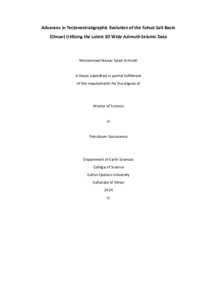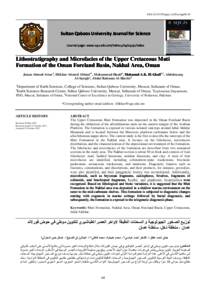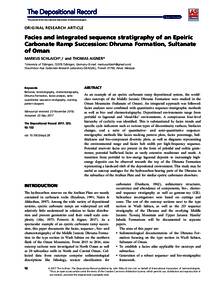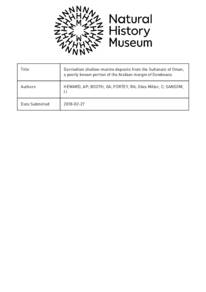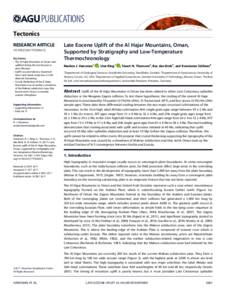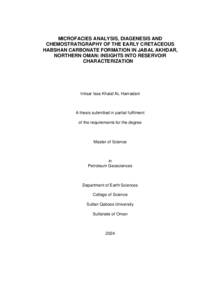Document
Advances in tectonostratigraphic evolution of the Fahud Salt Basin (Oman) utilizing the latest 3D wide Azimuth seismic data.
Source
Master's thesis
Other titles
التقدم في التطورات التكتونية الطبقية لحوض فهود الملحي (عمان) باستخدام أحدث بيانات الزلزلاية ثلاثية الأبعاد للسمت الواسع
Country
Oman
City
Muscat
Publisher
Sultan Qaboos University
Gregorian
2024
Language
English
Thesis Type
Master's thesis
English abstract
Seismic technology has significantly progressed since the discovery of most of
Oman’s oilfields in the 1980s and 1990s, with the emergence of 3D Wide Azimuth (WAZ)
since ~2010 revealing new subsurface images. Petroleum Development Oman (PDO) has
developed advanced processing techniques to address seismic imaging issues and
innovatively created the Megacell technique, which merges various 3D seismic volumes.
This overcomes disunited seismic data challenges and enables comprehensive regional
analysis in the Fahud Salt Basin (FSB). This integration offers unprecedented seismic
insights, yet its full potential in researching the tectonostratigraphic evolution of the FSB
remains underutilized. This study builds on previous work, using seismic imaging and
structural geology techniques to piece together the evolution of the basin.
Ten regional stratigraphic horizons and numerous faults were mapped from the
Late Neoproterozoic to the present-day using 3D seismic and deep wells data across an
area of 32,418 km². The focus was on the main bounding features that significantly exert
structural controls in the evolution of the basin. The study underscores the significant
impact of Late Neoproterozoic structures, variations in Ara salt thickness and geometry
on the development of main structural elements, including faults and folds, in key areas
like the Fahud, Natih, and Yibal fields and the main thrust front of Oman Mountains.
Utilizing the advanced WAZ 3D seismic semblance attribute and in-depth
geological field studies and maps, this research provides a novel understanding and
mapping of the Maradi Fault Zone (MFZ). The Yibal-Khuff structural formation was
developed in the region with the thickest Ara salt, which was distanced from the main
thrust front, allowing the salt to function as a ductile core, causing buckling in the
overlaying rocks at a more regional level. Moreover, the pre-existing Neoproterozoic
structural grain influenced fault development and growth in the overlying strata.
Detailed geological map analysis in the Fahud and Natih areas was integrated to
link the surface geology to subsurface seismic data. This helped extend the
interpretations, guided by a comprehensive understanding of Oman's regional tectonics.
Structural reconstruction was applied to a 222 km regional line traversing the Hawasina
Thrust Sheets (main thrust front), MFZ, Natih, and Fahud fields, and the southern extent
of the Yibal Field. It is instrumental in synthesizing regional observations and charting
the basin's evolution from the Ara salt deposition to the present.
This research aids in constructing an updated burial history for the basin, offering
novel insights for field development and exploration strategies. The method, starting
from a broad regional perspective and refining to detailed fields and fault zones, enabled
a redefinition and testing of regional observations.
Arabic abstract
لقد أحرزت عملية الحصول عىل البيانات الزلزالية ومعالجتها تقدما ملحوظاً منذ اكتشاف معظم حقول النقط العمانية في الثمانينيات والتسعينيات.كان ظهور تقنية الزلازل ثلاثية الأبعاد السمت العريض WAZبعد عام 2010 أمرا محوريا في الكشف عن صور جديدة تحت سطح الارض. كما تم تطوير تقنيات المعالجة متقدمة لمعالجة مشكلات مثل محتوى التردد والمضاعفات والمؤثرات الزلزالية المختلفة. قامت شركة تنمية نفط عمان (PDO(بتطوير تقنية Megacellبشكل مبتكر وهي تقنية تقوم بدمج مختلف البيانات الزلزالية ثلاثية الابعاد.
Category
Theses and Dissertations

